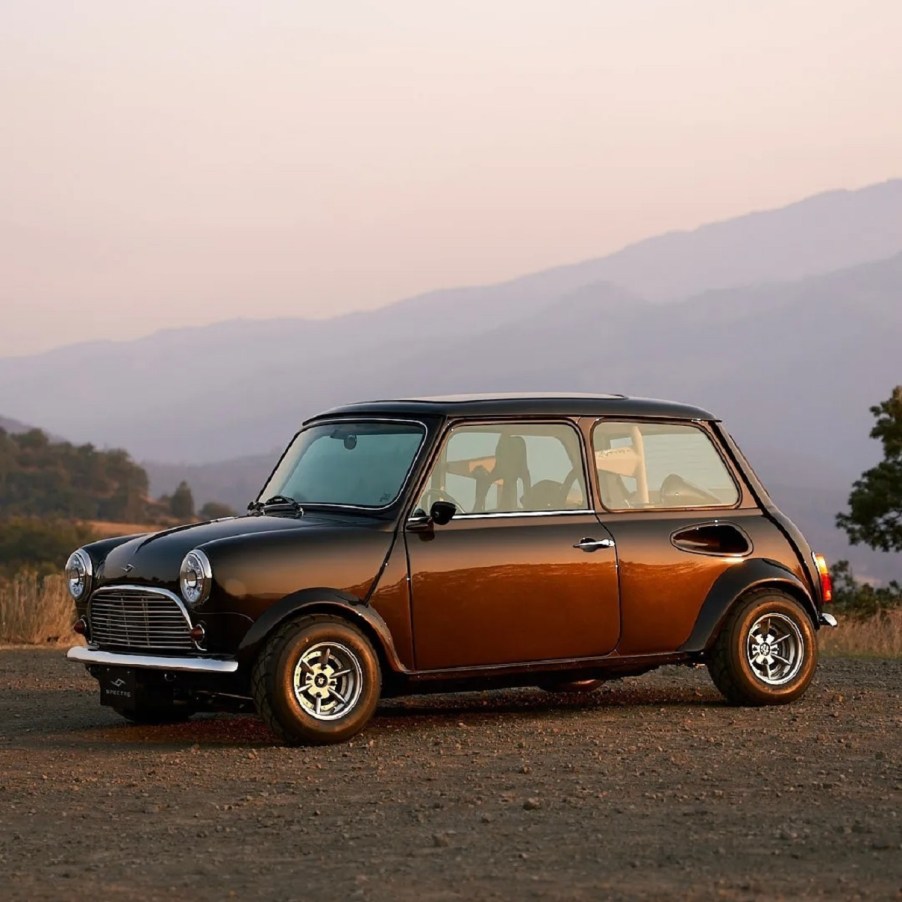
Spectre’s Type 10 Is a Mid-Engine Mini Cooper Restomod for Haunting Corners
Engine swaps can drastically change not just a car’s performance, but also its character. And that holds for classic cars just as well as for modern ones, if not more so. Hence why many restomods ditch the donor car’s powertrain for something newer and more powerful (or even electric). However, some builds go further than that. And the Spectre Type 10 is one of those next-level classic Mini Cooper builds.
The Spectre Type 10 turns the classic Mini Cooper into a mid-engine, RWD “performance monster,” Road & Track says

Normally, a classic Mini Cooper is a front-engine, front-wheel-drive hatchback. And even in Monte Carlo Rally Cooper S form, it makes less than 100 hp. The Type 10, built by North Vancouver-based Spectre Vehicle Design, though, changes all of those things.
Turning a classic Mini Cooper into a Spectre Type 10 starts by stripping the hatchback down to the bare bodyshell. That’s actually the only original part left once the restomod process is over, Autoblog says. Spectre removes the original powertrain and installs a 2.0-liter Honda K20 four-cylinder engine with a six-speed manual and a limited-slip differential. But that engine gets mounted in the middle, not in front. And it drives the rear wheels, rather than the front ones.

In essence, the Spectre Type 10 is a classic Mini version of the Renault 5 Turbo and Sport Clio V6. One that makes an estimated 230 hp at the wheels and weighs roughly 1700 lbs fully fueled. That means the Type 10 has “a power-to-weight ratio firmly in [Porsche 718] Cayman GT4 territory,” Road & Track reports. And feeding that engine requires extra air intakes and vents, hence the new bodywork.
To be fair, Honda-engine-swapped classic Mini Coopers aren’t necessarily new. However, the rest of the Spectre Type 10 approaches differently than some other examples. For instance, Spectre wanted to keep the Mini’s original 10” wheel size. That required designing a custom trailing-arm suspension system. Oh, and those wheels are three-piece, CNC-milled aluminum designs with spokes that vent hot air from the brakes. Speaking of, the Type 10 has four-wheel disc brakes.
Road & Track also calls the restomod’s interior “an oasis of beauty”

Besides tackling the mechanical components, the Spectre team also redid the classic Mini Cooper’s interior in making the Type 10. And the result is something like a Mid-Century Modern house by way of Japan, Autoblog muses. That’s not an idle simile, by the way: Spectre’s Emmy-winning creative designer was inspired by Japanese mudrooms, Top Gear reports.
Instead of the original dash, the Spectre Type 10 has one made from Canadian ash wood and set with three metal gauges. The shifter is made out of metal, too. There’s also a full roll cage inside, only it’s wrapped in stitched leather to match the rest of the interior. The optional full-carbon-fiber bucket seats have leather padding, too, as does the center armrest.
Also, this classic Mini Cooper now has a glass sunroof. And it appears to have some form of modern HVAC, too, as well as two cupholders.
How much does it cost to turn a classic Mini Cooper into a Spectre Type 10?
Spectre is initially building ten Type 10 ‘launch editions,’ and they’re not cheap. Prices start at $180K, though it’s unclear if that includes the cost of the donor car. Fortunately, you can pick up a well-maintained non-Cooper classic Mini for roughly $15K-$20K, Hagerty says.
Admittedly, that’s a lot of money for a Mini. However, you can make a similar statement about one of Singer’s or Gunther Werks’ 911 restomods. And given the material and engineering quality demonstrated, that price might be reasonable. Plus, how many vintage Minis can hang with a Cayman GT4?
Follow more updates from MotorBiscuit on our Facebook page.


